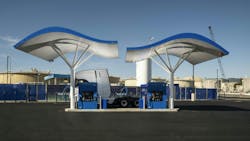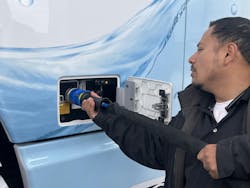Where alt-fuel infrastructure stands today: hydrogen, RD and biodiesel, and natural gas
This is part two of a two-part series on the status of alternative fuel infrastructure in the United States. Read part one here.
Any statement acknowledging the challenges of decarbonization could resonate with fleet owners, but some statements hit differently. Dave Hull, regional VP of Bosch Rexroth, said this at an industry event in April: “There are people investing in the vehicle space ... Find somebody that’s doing something in the distribution space."
Hull was referring to alternative fuels and the way that OEMs are making large investments into vehicles powered by electricity or through other renewable or emission-free energy. While these vehicles are largely available to fleet owners and operators, it's the means to fuel or charge them that keeps some fleet owners from considering these vehicles altogether.
Part one of this series covered the status of charging infrastructure for BEVs. This article will cover the infrastructure development of hydrogen, renewable diesel and biodiesel, and natural gas.
Hydrogen fuel distribution
Hydrogen is currently delivered to fleets in two primary ways: wet-hosing services, which entails having a fuel provider bring fuel to the fleet trucks either at the depot or in the field; and hydrogen fueling stations.
An upside to purchasing hydrogen-fueled vehicles, either with internal combustion engine propulsion systems or hydrogen fuel cell EVs, is that OEMs of hydrogen-fueled vehicles are often willing to help fleets with fueling. Nikola is doing this.
Nikola, which builds the Class 8 Tre FCEV, is developing its refueling infrastructure through its Hyla brand. The OEM opened its second Hyla refueling station in May, with more to come. Nikola’s Hyla network also provides modular stations, or mobile refueling solutions, where hydrogen is stored in trailers that fleets can place on their property.
Hyzon, manufacturer of retrofittable hydrogen fuel cell systems, helps its customers with hydrogen fueling through partnerships with existing fueling stations. The company recently facilitated a partnership between Pilot and Performance Food Group, a fleet that operates five hydrogen fuel cell EVs. Through this partnership, Pilot sends a hydrogen-filled tank truck to PFG’s depot to fuel the trucks.
See also: A new kind of fueling system helps scale H2 infrastructure
Much like with electric vehicle charging infrastructure, there are companies that are solely dedicated to bringing hydrogen infrastructure to scale for the masses. One of those is BayoTech, a hydrogen infrastructure development company that includes hydrogen production, transport, and storage solutions. The company partners with fleets that operate FCEVs to bring them hydrogen fuel either through hydrogen transport trailers that fleets can keep at their depot, long-term bulk gaseous hydrogen storage, or gaseous hydrogen storage on smaller, compact trailers that can be taken almost anywhere.
While there are some refueling options for fleets that operate hydrogen-powered vehicles, public refueling options are fewer, but in development. FirstElement Fuel recently opened a public hydrogen refueling station in the Port of Oakland, and through its Hyla brand, Nikola is working to create more public hydrogen refueling stations across the West Coast.
Most of the attention for public hydrogen refueling comes from the state of California, leaving fleets that operate in other states with few public refueling options. This means that any fleet hoping to operate hydrogen-powered vehicles would be limited to the range in which they can operate—ensuring that each vehicle stays within a certain radius of their hydrogen fuel source.
Renewable diesel and biodiesel infrastructure
The alternative fuel source that is the simplest for the end user is renewable diesel or biodiesel. Renewable diesel features the same chemical makeup as diesel; therefore, no engine modifications are required. Because of this, RD is considered a “drop-in” fuel. Volvo recently announced it will use the fuel, specifically hydrotreated vegetable oil—made from vegetable oils and animal fats—in each newly assembled truck that leaves its facility destined for customers. This move underscores the fuel’s potential in any application that requires diesel fuel.
Advocates for renewable diesel and biodiesel tout that the infrastructure for the fuel types is already available.
“As we're looking at the drop-in solutions for renewable diesel and biodiesel, that's certainly much simpler in comparison to the other solutions as they are drop-in solutions,” Dr. Nuray Elci, VP of innovation and technology ventures at Chevron, said in a webinar hosted by Gladstein, Neandross & Associates. “So, you can use the existing infrastructure in existing vehicles.”
Transitioning the industry from diesel to RD would result in a fraction (one-fifth) of the cost to transition the industry to BEVs when taking vehicle development and infrastructure costs into account, according to the American Transportation Research Institute’s report, “Renewable Diesel—A Catalyst for Decarbonization.”
See also: Renewable diesel could cut emissions for much less than electrification
Perhaps the problem bringing the fuel to market more broadly today is its controversial production. The ATRI report categorizes the sources of RD and biodiesel as a “first to fourth generation fuel.” First-generation RD is sourced from food-based products, such as soybean oil and distillers corn oil. “Some argue that first-generation biofuels directly compete with edible food supplies,” ATRI’s report states, which could cause “inflationary effects.”
Second-generation RD comes from waste productions, such as agricultural residues, wood materials, and used cooking oils. Third-generation RD, currently in the research stage, comes from “microalgae and cyanobacteria biomass,” and is used to generate alcohols and lipids, according to ATRI. Also in the research stage is fourth-generation RD, which is vaguely described as using “genetic engineering to increase desired traits of organisms used in biofuel production.”
Regardless, the Department of Energy lists 16 renewable diesel production plants in operation in the U.S. today, many of which have been converted from petroleum refineries. Additionally, renewable diesel and biodiesel are more widely available to the public, particularly in the Midwest, compared to hydrogen or other alternative fuels, with Illinois featuring the most public RD and biodiesel fueling stations at 477.
Natural gas infrastructure
Natural gas infrastructure is growing, despite fewer CNG vehicles delivered to fleets in 2023 compared to 2022, according to a market analysis by TRC. Renewable natural gas facilities grew by 150 stations in 2023, per the TRC analysis, and of the CNG fleets TRC surveyed, 81% expect their CNG use to grow or stay the same. This should keep demand for natural gas strong for the next several years.
See also: NACFE releases report on the viability of fleets fueled by natural gas
There are currently 334 renewable propane-producing facilities in the U.S., with a planned total of 821, according to the Renewable Natural Gas Coalition. The State of Sustainable Fleets 2024 report states that fleets that choose CNG and RNG to fuel their vehicles will easily avoid additional expenses when transitioning their fleet.
“With an established and growing network of public CNG stations dispensing RNG across North America,” the report states, “fleets looking to transition to clean RNG trucks can likely avoid the overwhelming, cost-prohibitive, multi-year refueling hurdles currently plaguing other advanced clean fuel technologies.”
Don’t pull the plug on alt-fuels yet
Transitioning the transportation industry to any other fuel or power source will continue to be an uphill battle, at least for the next decade. Yet, each alternative fuel has come a long way just within the past few years—and the industry can expect the innovation to continue.
The U.S. government has pumped billions of dollars into alternative energy through grants and incentives, fueling the innovation and research necessary to see these fuels and alternative power sources succeed.
See also: More funding for charging and alt-fuel infrastructure
OEMs continue to develop more alt-fuel equipment options, delivering more vehicles. Fleets are testing these vehicles in their operations, helping both OEMs and infrastructure developers fine-tune their approach to bringing these vehicles and fuels to market in the most efficient way. In many cases, partnerships are key to this evolution from fossil-fueled ICE vehicles to alternative-fueled vehicles or battery electric powertrains, with OEMs helping connect fleets to charging infrastructure developers or alternative fuel providers.
With the money and time spent rolling out these new BEVs and hydrogen FCEVs, along with the investment in charging infrastructure, hydrogen production and infrastructure, and developing renewable diesel and biofuels, the industry isn’t likely to see a regression from alternative fuel development any time soon—even when considering a U.S. presidential election coming this fall.
While regulations, both local and federal, are subject to change, the push for environmentally friendly transportation options will not. The best thing fleets can do is begin their EV, hydrogen, or renewable diesel journey as early as possible so that the road to clean trucking will be as smooth as possible.
About the Author
Jade Brasher
Senior Editor Jade Brasher has covered vocational trucking and fleets since 2018. A graduate of The University of Alabama with a degree in journalism, Jade enjoys telling stories about the people behind the wheel and the intricate processes of the ever-evolving trucking industry.


